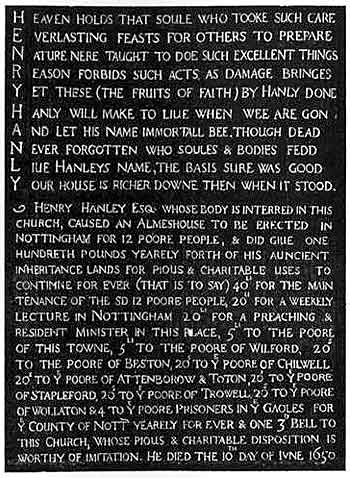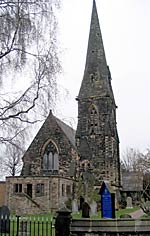EXTRACT FROM THE WILL OF HENRY HANLEY.1
"Item. My will is and I do devise that my said executors or the greatest part of them within one year next after any decease shall and do provide, finish, and lay or cause to be provided, finished or laid, comely and decent grave-stones for the graves of Percival Hanley my son and heir lately deceased and Mary Hanley my daughter deceased and according to their ranks and qualities lawful and commendable inscriptions thereupon and likewise one tomb or monument for the graves of myself and Margaret my deceased wife with the inscriptions as aforesaid."
In this paragraph, of his will, the existence of Percival and Mary, his two children, is confirmed.
Henry Hanley died on 10 June, 1650, and was buried at Bramcote Church. With him ended the Bramcote branch of the family.
There is a mural tablet to him, which has recently been removed from the old church tower, and is now on the southern respond of the chancel arch of the present church. This tablet is surmounted by the Hanley arms, as shown at the head of this paper, and is in acrostic form.
The numerous charities founded by this magnanimous man are set out in full, in the appendix to Deering's History (pp. 321-330); also in Blackner's History, p. 139 (not 189 as printed). They benefitted eight parishes contiguous to the parish of Bramcote. His most notable gift, however, was the foundation of twelve alms-houses in the town of Nottingham. All particulars, and an illustration of the twelve original houses in Barker Gate may be found in Deering's History (p.151). The right of nominating inmates to these wretched one-roomed houses was vested in the Mayor of Nottingham, the Earl Manvers, and Mr. John Longden of Bramcote. The property became very dilapidated, and some expense fell upon the town funds in order to maintain it, a charge which the ratepayers resented; eventually the site on which they stood was sold for a considerable sum, and new alms-houses were erected on less costly land, at the corner of Wollaton Street 'and a new street, named Hanley Street (note the spelling of the name), in the year 1815.

Another bequest made by this well meaning benefactor led to contention, viz.—the gift of a sum of £20 a year to a minister, whose duty it was to read a "lecture" once a week. This fell into disusage (1768), and the stipend remained unclaimed for three years, after an unbecoming controversy between the Vicar of St. Mary's, and the last lecturer, one Rev. Davenport (see Blackner, p.141). Blackner says:—"the legacy remained undemanded during three years; and from that time it has been lost, and that part of the donor's will perverted. And this will be the case with the charitable purposes of the will altogether, if similar opportunities occur."
This makes one wonder if, during the lapse of 150 or more years, the donor's will has been further "perverted," as the board setting out the charities, which is still to be seen in several of the churches bene-fitted, is the chief evidence of such a benefactor having existed.
The second and last Henry Hanley died wifeless and childless ; let us hope that he did not foresee the trouble that would arise, in regard to property he still had at his disposal after instituting the foregoing charities. In Thoroton's History (p.210), it is stated, "that his kinsman Robert Harding, Barrister at Law, keeps it (the estate) in his possession though Gervase Handley of Wilford did make some attempt to obtain it before he died by suit of law." Gervase Handley appears to have been no match for his legally trained kinsman. Presumably Harding's conduct, in this matter, was not such as the late squire expected ; for the wording of his will indicates that he had every confidence in Hardy's integrity, when he appointed certain "loving friends," of whom "Robert Hardy alias Harding was one," to be his supervisors and overseers, for the true and just performance of his will. There seems to be nothing in the will, to justify Robert Hardy, holding the estate against all comers ; as the property is not devised, by the will set out at length in Deering's History, to any one specifically.
The compilation of this paper seems to afford a good opportunity for a few remarks on the church wherein the Hanleys worshipped, and the manor-house wherein they lived.
Of the old church, which was dedicated to St. Michael and all Angels, the tower alone remains as already stated, the body of the church having been pulled down about the year 1861. It appears to have been a fourteenth century building; and that it had at least one aisle, is evident from the wording on the monumental tablet to Henry Hanley as to his place of burial, viz.:— "in the east end of the Southe Alley." When the demolition of the church took place, the tower arch and a portion of the surrounding eastern wall were cut away, and a thinner wall was built up, having a small entrance doorway made up of old arch stones. Above the doorway, a two-light square-headed window of the Decorated period was inserted. In all probability it had been rescued from the body of the church. The peal of three bells, of which the third bell was given by H. Hanley, was transferred from the old tower to the new church, being at the time recast and rehung, by Messrs. Taylor & Sons of Loughborough, by whose courtesy we learn that the old bells bore the following inscriptions:—
Treble—God Save the Church, 1600.
Second—Jesus be our speed.
Tenor—Thos. Hedderley, founder, Wm. Barton, C. W., 1750.
 The 'modern church' at Bramcote (photo:
Andy Nicholson, 2006).
The 'modern church' at Bramcote (photo:
Andy Nicholson, 2006).The graveyard, in which the old tower stands, is small and cramped, and stands some feet above the level of the road, which surrounds it on two sides, and the tower is approached up a sharp incline.
It seems regrettable, that the commanding site selected for the building of the original church could not have been utilised again, instead of the modern church being erected in the street, lower down the village.
